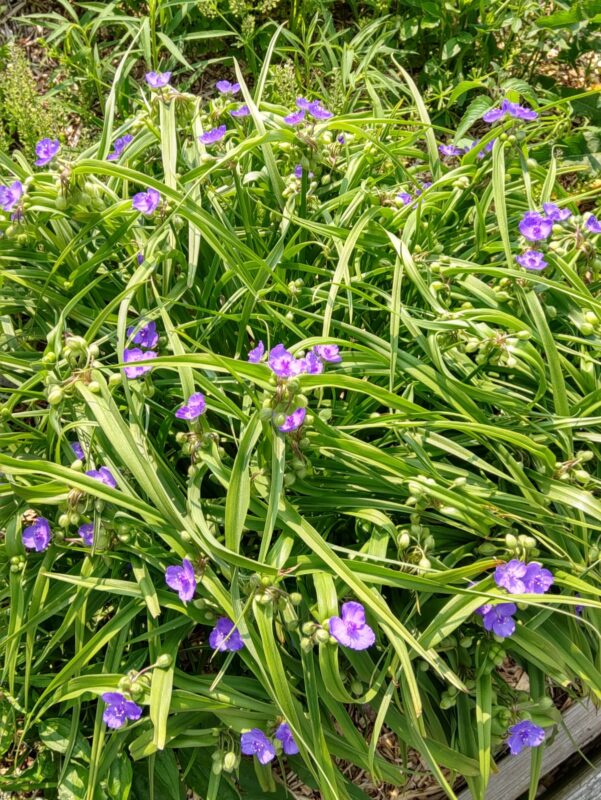This field trip was in the Cedar Bog (which isn’t actually a bog), a beautiful fen far outside of Columbus. The difference between a bog and a fen is pretty simple when explained with the phrase “bogs clog and fens flush”. The big difference is how water enters and exits the area; bogs are wetlands that get their water from rain and runoff, but the water can’t drain out. Fens on the other hand, can get their water from rain or underground springs, but can also leave via small streams. It’s said that water is always flowing in a fen, but bogs are stagnant! In Cedar Bog, water mostly enters from an underground aquifer, which is a remnant from the Teays River, previously discussed in my Batelle-Darby page! Cedar Bog is set within glacial hills called end moraines, made up of sandstone. Due to this material being permeable to water, it flows freely down into the aquifer for Cedar Bog.
While we were at this fen, we were given the task of identifying two plants that met certain criteria. My two were plants that were common in floodplains! The two species I found and would like to talk about are black ash (Fraxinus nigra) and swamp white oak (Quercus bicolor).
Black Ash
(Fraxinus nigra)
Black ash is a relatively uncommon species, unlike green and white ash. It is most similar to green ash, preferring wet sites and looks almost identical to green ash. The biggest difference between green and black ash is that black ash leaflets are sessile, meaning they have no petiole or stem. Besides that, they look like your typical opposite, pinnately compound-leafed ash tree. Many species rely on ashes for food, especially North American frogs! Since black ashes commonly grow in swampy environments, the leaves often fall into bodies of water, where tadpoles can easily feed.

Black ash.
Swamp White Oak
(Quercus bicolor)
Swamp white oak is another species common to floodplains. It is identified by its standard white oak bark and round-lobed leaves. What sets it apart from other white oak species is that the leaves are rounder, wider and less deeply lobed. Swamp white oak’s Latin name bicolor stems from the leave’s two-toned appearance: dark green on top and lighter on the bottom.

Swamp white oak bark
Conservative Plants
This next section is about mentioning some of the conservative plants we saw in Cedar Bog! The four plants pictured below are fern moss (Thuidium delicatulum) with a coefficient of conservatism (CC) of 3, Ohio spiderwort (Tradescantia ohiensis) with a CC of 5, climbing prairie rose (Rosa setigera) with a CC of 4, and chinquapin oak (Quercus muehlenbergii) with a CC of 7.

Fern moss

Ohio spiderwort

Climbing prairie rose

Chinquapin oak
We also wanted to touch on the two ash species we found out in the fen: black and green ash. I had already mentioned black ash (Fraxinus nigra) above, and green ash (Fraxinus pennsylvanica) is very similar! They both have pinnately compound, opposite leaves, are found in wetland sites, and are threatened by the emerald ash borer. As mentioned above as well, the largest difference between the two is that black ash leaflets are sessile, meaning there is no stem or petiole between the leaf and leaflet.

Green ash leaf
FQAI Tables
Here, I’ll recreate a FQAI table for two plant communities, giving each plant’s scientific name, common name, wetland status, coefficient of conservation and calculated total FQAI value.
Swamp Forest
Scientific Common Wetland Status CC
Caltha palustris. marsh-marigold OBL 6
Iris viginica Southern blue flag OBL 6
Lindera benzoin spicebush FACW- 5
Senecio aureus golden ragwort FACW 4
Symplocarpus foetidus skunk-cabbage OBL 6
Ranunculus septentrionalis swamp buttercup FAC 4
The FQAI value is (6+6+5+4+6+4)/sqrt(6) = 12.7
Sedge Meadow
Scientific Common Wetland Status CC
Dasiphora fruticosa shrubby cinquefoil FACW 10
Drosera rotundifolia round-leaved sundew OBL 7
Betula pumila swamp birch OBL 10
Valeriana uliginosa swamp valerian FACW+ 10
Toxicodendron vernix poison sumac OBL 7
Utricularia minor lesser bladderwort OBL 6
The FQAI value is (10+7+10+10+7+6)/sqrt(6) = 20.4
